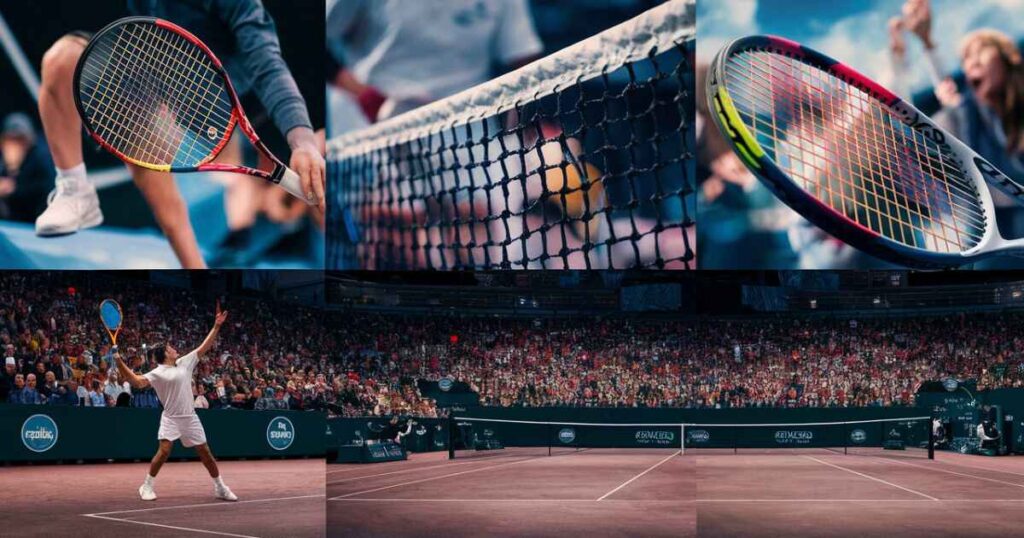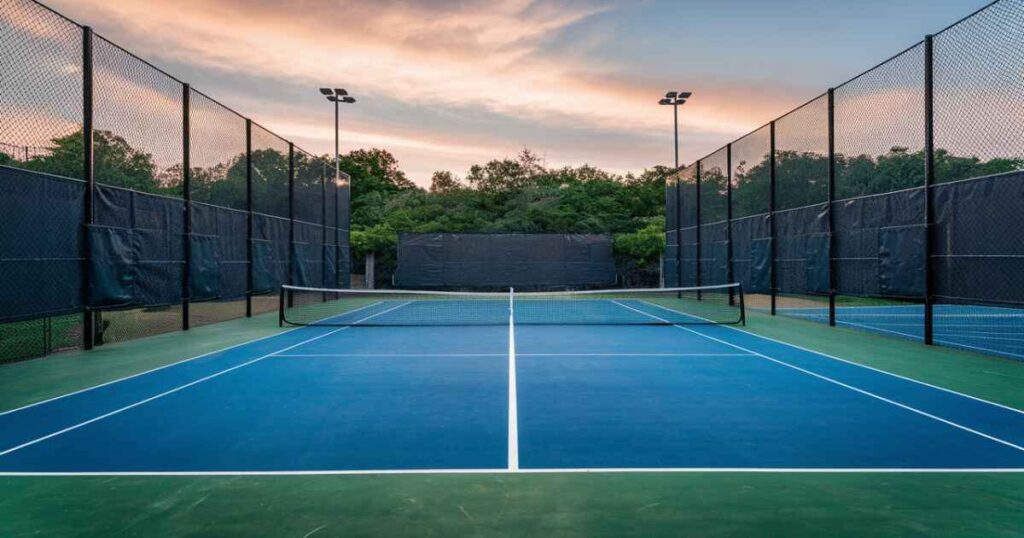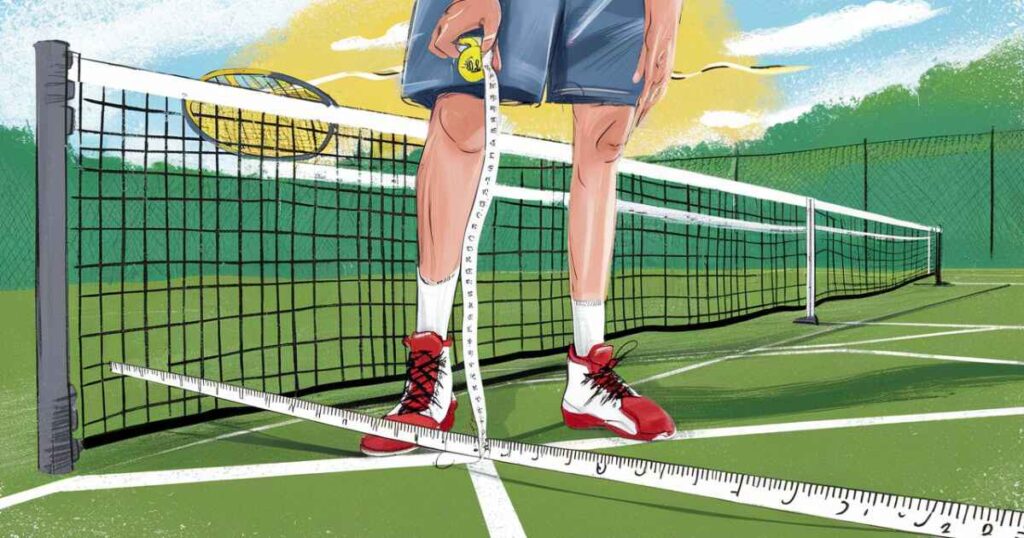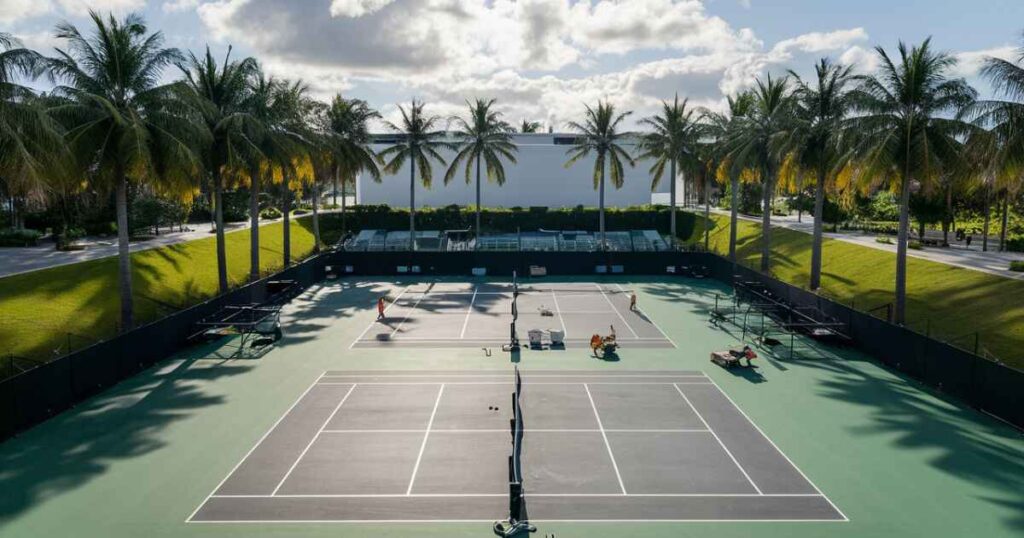A tennis court is a rectangular playing surface for the sport of tennis. It has specific markings and dimensions. The court is divided by a net in the middle. Players hit a ball back and forth over this net. Tennis can be played on various surfaces like grass, clay, or hard courts.
The lines and measurements may seem complex at first glance. But understanding the court’s design can enhance your appreciation of the game. It can also improve your playing strategy and enjoyment of tennis matches.
Tennis courts have standard dimensions for both singles and doubles play. The court is 78 feet long and 27 feet wide for singles matches. For doubles, the width increases to 36 feet. The net height is 3 feet at the center. Various lines mark different areas of play. These include the baseline, service lines, and alleys.
Baseline: Doubles 36 feet / Singles 27 feet

The baseline is where much of the action happens in tennis. It’s the line at each end of the court from which players serve and often rally. For doubles, this line stretches the full 36-foot width of the court, while in singles, players must stay within the 27-foot width. Understanding the baseline length is crucial for players as it affects everything from serve placement to defensive positioning.
Center Mark: 4 inches long
In the middle of the baseline, you’ll find a small line perpendicular to it – the center mark. This 4-inch line might seem insignificant, but it plays a vital role in serving. Players must stand to the right or left of this mark when serving, ensuring fairness and consistency in the game. The center mark tennis court element is a small but important detail that helps maintain the integrity of the serve.
42 feet long center service line
Running down the middle of the court is the center service line. This line divides the service boxes and extends from one service line to the other. It’s a key reference point for players, especially when serving, as it helps them aim their serves into the correct service box. The center service line doesn’t extend all the way to the baselines, which is why it’s 42 feet long rather than the full 78-foot court length.
27 feet wide service line
Parallel to the net and 21 feet from it on each side is the service line. This line, which runs the width of the singles court (27 feet), marks the boundary for serves. Any serve that lands beyond this line is considered out. The area between the service line and the net is crucial for net play and volleys, making it a hotspot for exciting exchanges during a match.
39 feet long doubles sidelines
The doubles sidelines run the length of the court, defining the lateral boundaries for doubles play. At 39 feet long, these lines create the wider playing area that makes doubles tennis so dynamic. The space between the singles and doubles sidelines – the doubles alley – is fair game in doubles matches, leading to thrilling wide-angle shots and strategic positioning.
39 feet long singles sidelines
For singles matches, the playing area narrows, and the singles sidelines come into play. Also 39 feet long, these lines run parallel to the double sidelines but are closer together. Mastering awareness of these lines is crucial for singles players, as any ball landing outside them is out of bounds. The ability to hit shots that land just inside these lines often separates good players from great ones.
Read More: How Many Players on a Soccer Team? Laws of the Game?
Different Areas of the Tennis Court

A tennis court is more than just a rectangular playing surface. It’s divided into several distinct areas, each with its own strategic importance. Understanding these areas can help players improve their game and give spectators a deeper appreciation for the sport. Let’s explore the key zones that make up a tennis court and see how they influence gameplay.
The most fundamental division on a tennis court is between the two halves separated by the net. Each half contains identical features, creating a symmetrical playing field that ensures fairness for both players or teams. Within these halves, various lines and markings create specific areas that dictate how the game is played.
Service Box
The service box is where every point begins. Located in the front quarter of each side of the court, these rectangular areas are defined by the sideline, service line, center service line, and net. In tennis court area calculations, each service box measures 21 feet by 13.5 feet. The server must land their serve within the diagonally opposite service box for the serve to be considered in play.
Doubles Alley
The doubles alley is the strip of court between the singles and doubles sidelines. This area, measuring 39 feet long and 4.5 feet wide on each side, comes into play only during doubles matches. The inclusion of the doubles alley in doubles play significantly changes the geometry of the court, allowing for wider angles and different strategic approaches compared to singles play.
Center Line
The center line runs from the middle of one service line to the other, dividing the service boxes. While it doesn’t extend the full length of the court, this line plays a crucial role in serving. The server must stand to one side of the center mark (an extension of the center line) on the baseline when serving, alternating sides for each point. This ensures that serves are distributed evenly between the deuce and advantage courts.
Backcourt (No Man’s Land)
The area between the service line and the baseline is often referred to as ‘no man’s land’ or the backcourt. This section of the court, measuring about 18 feet in depth, can be a tricky area for players. It’s too far back for effective volleys but too close to the net for comfortable groundstrokes. Skilled players learn to navigate this area quickly, using it as a transition zone rather than a place to play from consistently.
Tennis Court Net Height
The net is the central feature of any tennis court, dividing the playing area in half. Tennis court net height is standardized to ensure consistency across all levels of play. At the posts, the net should measure 3 feet 6 inches (1.07 meters) high. The center of the net is slightly lower, at 3 feet (0.914 meters), held down by a center strap.
Choosing the Best Tennis Court Size for Your Home

For tennis enthusiasts dreaming of having their own court, understanding home tennis court size options is crucial. While professional courts have standardized dimensions, home courts can be adapted to fit available space without compromising too much on playability. The key is finding the right balance between court size and the practical limitations of your property.
When planning a home tennis court, consider not just the playing area but also the surrounding space needed for player movement, fencing, and possibly spectator areas. While you might be tempted to squeeze in a full-sized court, a slightly smaller court that allows for proper clearance and safety margins is often a better choice for home play.
Minimum Play Area for Home Tennis Court
The smallest recommended size for a home tennis court is about 100 feet by 50 feet. This allows for a full-sized playing area plus minimal clearance around the edges. While this size can work, it’s important to note that it leaves little room for error or overruns. Players might find themselves limited in their movement, especially when chasing down wide shots or deep lobs.
Ideal Play Area for Home Tennis Court
For a more comfortable playing experience, an ideal backyard tennis court dimensions would be around 120 feet by 60 feet. This size provides ample room for the full court dimensions plus generous clearance on all sides. With this layout, players can move freely without fear of running into fences or other obstacles. It also allows space for small seating areas or storage for equipment.
Maximum Play Area for Home Tennis Court
For those with plenty of space and a desire for a truly professional feel, a maximum play area of about 130 feet by 70 feet can be considered. This generous size mimics professional tournament courts, providing extensive run-off areas and space for amenities like scoreboards or camera equipment. While not necessary for most home players, this size can be ideal for serious players or those who plan to host local tournaments or events.
Measuring a Tennis Court: Tips and Tricks

Accurate measurement is crucial when it comes to tennis court construction or maintenance. Whether you’re laying out a new court or checking the dimensions of an existing one, precision is key to ensuring fair and enjoyable play. Professional court builders and maintenance crews use specific techniques to ensure every line and boundary is exactly where it should be.
Before you start measuring, it’s important to have the right tools. A long measuring tape (at least 100 feet) is essential, as is a set of marking stakes or pins. Some pros also use laser measuring devices for extreme accuracy. Remember, when measuring tennis court lines, you’re measuring from the outside edges of the lines, not the center.
Standard Tennis Court Size
The standard tennis court dimensions for singles play are 78 feet long by 27 feet wide. For doubles, the width increases to 36 feet. These measurements are for the actual playing area only. When measuring for construction or fencing, you’ll need to account for additional space around the court. A good rule of thumb is to add at least 12 feet to the length and 12 feet to the width for adequate clearance.
Courts for Tournaments or Stadiums
Tournament and stadium courts often require even more space. The tournament tennis court size typically includes additional clearance for player overruns, official’s chairs, and sometimes camera equipment. For major tournaments, courts might have total dimensions of 130 feet by 70 feet or even larger.
Measuring Tennis Court Dimensions
When measuring a tennis court, start with the baselines. Measure the full width of the court from outside edge to outside edge of the baseline. Then, measure the length of the court from one baseline to the other. For doubles courts, measure the width at both the baseline and the net line to ensure the court doesn’t taper. Use stakes or markers at each corner to keep your measurements square.
Side Space and BackSpace
Adequate side and back space is crucial for player safety and comfort. The United States Tennis Association (USTA) recommends a minimum of 12 feet of clear space behind each baseline and 12 feet beyond each sideline. For high-level play or in enclosed areas, even more space is beneficial. This extra room allows players to chase down wide shots and deep lobs without risk of collision.
Overhead Space
For indoor courts or those with lighting fixtures, overhead clearance is an important consideration. The USTA recommends a minimum ceiling height of 20 feet over the baseline and 35 feet over the net for indoor facilities. This allows for high lobs and overheads without interference. Outdoor courts with lighting should also consider these clearances to ensure unobstructed play.
Backstops and Fences
Proper fencing or backstops are essential for containing balls and ensuring smooth play. For residential courts, fences should be at least 8 feet high, while club or public courts often have 10-foot fences. The fencing should extend at least to the sidelines, if not beyond, to catch wide shots. Some courts use a combination of fencing and backdrop curtains for better ball visibility and wind protection.
Tennis Court Markings
Accurate tennis court markings are crucial for fair play. All lines should be between 1 and 2 inches wide, except for the baselines which can be up to 4 inches wide. When measuring for line placement, remember to measure to the outside edge of where the line will be painted. Use a chalk line or string to ensure straight lines before painting. Regular repainting of lines is necessary to maintain visibility and accuracy.
Building a Tennis Court

Building your own tennis court is an exciting project that can provide years of enjoyment and exercise. However, it’s a complex undertaking that requires careful planning and execution. From choosing the right location to selecting appropriate materials, every step of the process is crucial to creating a high-quality, long-lasting court.
The first step in building a tennis court is site selection and preparation. Look for a level area with good drainage, away from trees that could drop leaves or sap onto the court. The site should also be oriented north-south if possible to minimize sun glare for players. Once you’ve chosen your site, you’ll need to clear and level the area, possibly bringing in fill dirt to create a stable base.
VMKON Sports Courts
When it comes to court surfaces, modern technology has brought exciting new options to the table. VMKON Sports Courts offers innovative flooring solutions for both indoor and outdoor tennis courts. Their products are designed to provide excellent traction, reduce joint stress, and withstand various weather conditions.
VMKON’s court systems often use interlocking tiles or seamless poured surfaces that can be installed more quickly than conventional courts. They also offer customizable color options, allowing you to create a unique look for your court. While these high-tech surfaces might have a higher upfront cost, their durability and performance benefits.
Read More: The Top Fantasy Football Team Names for 2024
Frequently Asked Questions
What’s the difference between clay and hard court dimensions?
The actual playing dimensions of clay and hard courts are identical. Clay courts often have more space around the playing area to accommodate the sliding nature of play on clay.
How do doubles court dimensions affect strategy?
The wider court in doubles (36 feet vs. 27 feet for singles) allows for more angled shots and requires different positioning strategies.
Can I build a smaller court for practice at home?
You can build a smaller court for practice. While it won’t allow for full-scale play, a mini court (often about half the size of a regular court) can be great for drills and casual games.
Why are Wimbledon courts slightly different?
Wimbledon courts have the same playing dimensions as other courts. They often have more space around the court, particularly behind the baselines, to accommodate.
How often should court lines be repainted?
The frequency of repainting depends on usage and weather conditions. High-traffic courts might need touch-ups annually, while less-used courts might go several years between full repaintings.
Conclusion
In conclusion, understanding tennis court dimensions and layout is key for players and fans alike. From the baseline to the net, every line and area serves a purpose, shaping how the game is played. Whether you’re looking to improve your game, build a court at home, or just appreciate the sport more, knowing these details can make a big difference. While official courts have set sizes, home courts can be adapted to fit your space. The most important thing is to enjoy the game, no matter the court size!

